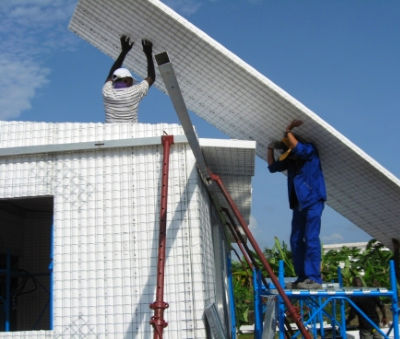
At the end of this article, I also briefly discuss remodeling a cement house.
I have spent my entire career building with wood: in Seattle, Alaska, even in Japan. So it seems strange for me to take such a strong stance against building with wood. Especially in Puerto Armuelles, which initially was built entirely with wood. The United Fruit Company, later Chiquita Banana, built Puerto Armuelles from the ground up using red cedar 2x4’s they shipped down from Portland Oregon.
I suppose if I were 36, or 46, rather than 56, I might feel differently. Or if I hadn’t already spent half of my life remodeling houses. Or if the weather were cool, as it is in Seattle, or Alaska.
I have met guys from various parts of the south, including Houston Texas who have told me that “Where I’m from it is 20 degrees hotter today”. These guys work in blue jeans in Panama. I have spent the better part of my adult life in the Pacific Northwest. On the hottest days in Panama, I sweat just standing still.
I guess what I am trying to convey is that it depends a great deal on the personality, and talents of the potential remodeler. If you are one of those men, or women, who has a tough time sitting still, or if you have looked forward to retirement so that you would have time for projects like remodeling an old Chiquita Banana house in Panama, then remodeling and old wooden house here might be just your cup of tea.
If you can pick up an historic, wooden Chiquita Banana house cheap and in good condition, it might be worth it. (Don’t forget to read the section on “termites” in my article on building with wood. Termites abound in coastal Panama, and they love to eat wood.)
Ten years ago wooden Chiquita homes in Las Palmas were going for $10,$20, $30,000. However, the current asking prices for the nicest homes in Las Palmas is in the $120k-$350k range. You can still pick up a deal, but the house is unlikely to be in good shape.
I would advise, as with any purchase in Puerto Armuelles, that you take your time, ask around. Eventually, you will find what you are looking for at a price that fits your budget.
In some of the less elite neighborhoods (that paradoxically are closer to the beach) deals are easier to come by. I think that, with patience, you still might be able to buy a wooden house in Carmen for under $14K, possibly even $11k. Carmen is a densely populated, working class neighborhood (noisy on the weekends). But Carmen is very well located on the ocean breakwater, at the south end of the downtown. The quality of the houses is already slowly improving in El Carmen, due to an inflow of new money into town. Many locals, even a couple of expats, are repairing and remodeling in Carmen. Prices can go nowhere but up.
Pressure treated 2x studs are available in David, imported from Canada and Chile, I believe. But they are expensive. At my last investigation, 2x6 pressure treated hem-fir cost over $2.00 per lineal foot. Prices may have come down, due to increasing demand; In the near future this may not be an unusual product anymore.
(Important note: I am not certain that I would want to live in a house made of such toxic wood, particularly if the framing lumber was left exposed. If that happens, the homeowner would end up in direct daily contact with the pesticide- impregnated wood.)
2. Labor cost. Another serious consideration when deciding whether or not to remodel a wooden house is labor cost.
On a per day basis, construction labor here in Puerto Armuelles is a steal. Workers get $20, $25, and $30 per day here. However, they don't have much experience working with wood. This means the efficiency level of these laborers is nowhere near a professional building crew in the States or in Canada.
A small 2 or 3 bedroom house that 2 skillful carpenters might frame in the States or Canada in a few weeks, could well take a crew of 6 men here several months to complete. And complete with a far lower quality of fit and finish. It is just not a woodworking culture.
There are those who would respond immediately “No Way. Don’t remodel a concrete block house. Far better just tear it down and start from scratch.”
I know from conversations with Milton Hutto, owner of Heavenly’s Hotel in San Vicente that he felt that he should have torn down the existing concrete house that became part of the West Wing of his hotel.
Most of his project was built using M-2, steel rebar, and concrete stucco. Obviously, Milton knows what he is talking about. He was there on-site during most of the construction, and he had prior building experience in Puerto Armuelles.
Watch a video of Milton talking about building a house in Panama, as an expat. Just click the link.
However, one should consider the scale of the project, before dismissing remodeling a concrete block house out of hand. In Milton’s case, he was building an 11 room hotel, not a small, single family, or single person dwelling. He employed a crew of at least 10 men. With this work force, costs were high, and quick progress was an absolute necessity.
Find out about building your house of concrete in Panama.

Or possibly an English-Spanish exchange network.
It would be a way for expat retirees to help young people in Puerto Armuelles improve their English.
As you can imagine, there are many more job and business opportunities open to Panamanians who speak English. It literally opens many doors for them here and internationally.
In Panama, where there is a wide gap between the upper class and the poor, helping a young person of modest means to improve their English skills might be the jumpstart they need to launch them, and their family, from the lower class into Panama’s growing middle class.
You really can make a difference in your world by volunteering to help another person. It is a satisfying way to maintain a grateful heart.
Not only is volunteering is a great way for expats to mix with locals, it is a an ideal way to practice your Spanish. And, of course, there is always the possibility of working out a trade: English lessons for Spanish lessons.
What’s more, you just might make a new friend for life. Who knows?
I am trying to get a rough idea of how many of our readers might be interested in participating in a language volunteer, or language exchange project. If you know someone who may be interested in volunteering, please let them know about our idea.
Is there anyone with a great organizational gift who would like to help with the logistics of setting up an easy-to-use system?
Please let us know. Send us an email, use our contact page, or comment below.
We welcome your suggestions, since this is new territory for us.
Thanks.
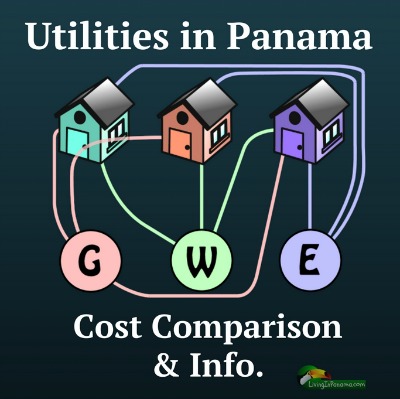
First of all, bill paying in Puerto Armuelles has not been a big preoccupation for us.
Bills here are so much lower than they are back in Seattle.
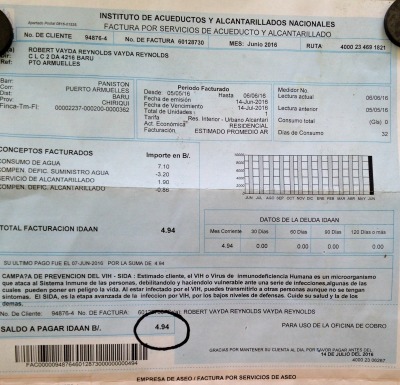
As you can see from the photo of the water bill (Instituto de Acueductos y Acantarillados or IDAAN), our water bill for June was $4.94, for unlimited water use.
By comparison, our water bill in Seattle is typically $150 per month in the winter, and up to $250 in summer. In Seattle, they charge you for the water both going in and going out of your house.
Our electricity bill in Puerto Armuelles is typically $35 per month. In Seattle, our summer electricity bill is about $300. Our highest winter bill was over $450 (we have electric heating).
We do not have air conditioning, but we are heavy users of fans and have a big and old refrigerator. We also have children who never remember to turn off a fan or light they are not using(!) You can see our electric bill below. Click on it to make it larger.
I looked up the electric rates in Seattle and Panama City to get a better comparison. 2 big cities.
Electricity in Panama has 3 rates, depending upon your use.
If you use less than 300 kWh, your rate is subsidized. Which is how some people have monthly electricity bills of only $4. If you use between 300- 750 kWh, you pay at a higher rate. If you use more than 750kWh, you pay at the highest rate. I couldn't figure out what that rate was, but that is the breakdown per kWh.
From conversations and reading, it seems clear that the rate charged at each of those kWh levels varies across the country.
Maybe it has something to do with whether your area is covered by Union Fenosa vs. Gas Natural Fenosa vs. the 2 electrical distributors (Empresa de Distribución Eléctrica Metro Oeste (Edemet), and Empresa de Distribución Eléctrica Chiriquí (Edechi) vs. Enca, which serves the northeast area of Panama
Gas Natural Fenosa of Spain is in charge of almost all the electricity in Panama though. Gas Natural Fenosa merged with Union Fenosa in 2009 and since then they bought 51% of the electricity distributors Edemet and Edechi. And they keep expanding. Perhaps all these subsidiaries and companies maintain separate rate structures? In Puerto Armuelles, the electricity bill (above) is issued by Gas Natural Fenosa, although everyone refers to it as Union Fenosa.
In general, if you use A/C all day every day, your electricity bill will likely be close to $300/month. If you use your A/C less, say just in your bedroom, your electricity bill will be more in the $100 to $150/month range.
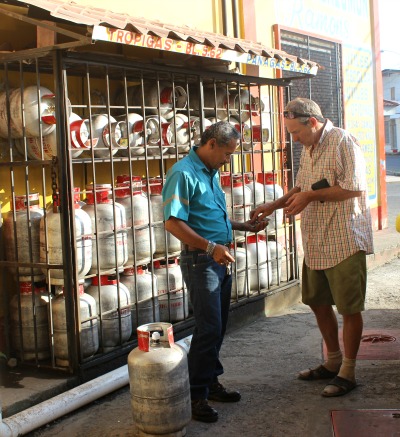
Our gas bill in Seattle is around $100/month. Here in Puerto, where there are no in-ground gas pipes, our bottled gas bill for our propane range/stovetop and our propane dryer is about $10/month. $5 a month for each bottle.
As you can see, compared to our costs in Seattle, we have substantial savings in our home utility bills in Puerto Armuelles.
Now for a question, I also get, "how to pay your utility bills in Panama". In that article about paying utility bills, I also give some information on a few other household bills such as
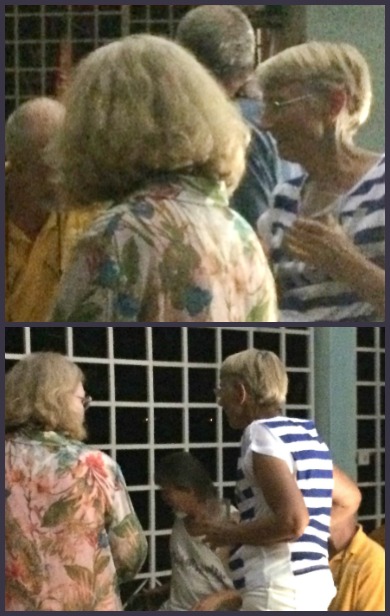
Loren rented a house in the Corazon de Jesus neighborhood of Puerto Armuelles for a few months.
She visited Puerto after spending over a year in Quito, Ecuador.
On her way out of town, Loren kindly wrote me about her experience and thoughts on living in Puerto Armuelles, Panama.
Since I am not within walking distance of downtown Puerto Armuelles, I take a taxi to and from the local market.
Shared Taxi Experience
Quite often when the driver stops for me, there are other passengers in the vehicle. The driver could just as easily pass me by, since he already has a fare. I especially appreciate his courtesy which gives me a chance to get out of the hot sun. This is quite a change from other places I have lived, where taxis pick up and deliver one fare at a time.
The interesting part of taking a shared taxi comes from discovering all the new places I get to see while we travel from Point A to Point B, which is often in the opposite direction from where I want to go. Along the way, we drop off the original passenger(s), perhaps pick up another passenger(s), then we might make an unscheduled stop for the driver.
Recently, I had one driver stop by his house to get more bottled water and on another occasion we first stopped by the driver's house so he could add water to his tank and fill the water dish for his chickens, lol!
This took about 5 minutes while I and another passenger waited in the car. Once that was done, we all headed to her destination and then back across town to my destination. So, for the same price, I get the Scenic Tour!
Everyone's Needs Are Equal & Respected
What this tells me is that this country respects the needs of all individuals. My need to get to the market is of no greater importance than the other passenger's need to meet her husband for lunch, nor greater in importance than the driver's need to take care of business at his home.
I like that about Puerto Armuelles ... there is the understanding that there is enough time for all things to get done and there is respect for all persons' needs.
Loren, thank you so much for sharing your thoughts on living in Puerto Armuelles.
If you want to share your experiences and views of Puerto Armuelles or Panama in general, please email them to me or use our contact form. We'd love to share your thoughts and experiences with others.
Or you can simply comment below.

The first time I had Panamanian tamales I was under-whelmed. I had a real fondness for tamales, Mexican tamales.
Initially, I was not thrilled with the wetness of tamales in Panama. It is definitely more messy to eat than a Mexican tamale. Of course, it didn't help that whomever had made them had skimped on the chicken. It was mostly cornmeal.
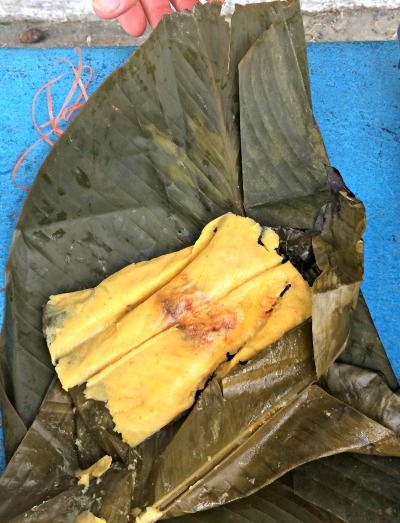
Over the years, I have grown to appreciate how much more flavor the "messy" cornmeal gives to the tamale. They cook the cornmeal in a well-spiced broth which gives it the flavor.
Now, whenever we find someone who is selling tamales we buy a few. We have learned now who puts an adequate amount of chicken in the tamales. And more importantly, who does not. I have never seen a tamale here made of anything but chicken.
I was visiting a family recently and saw these tamales cooking in their back yard (see photo). They made the tamales to feed a work crew at their house.
Making tamales takes quite a bit of work. Most people only make them during the holidays. It is a social activity, like cooking a meal for an American Thanksgiving.
To find out more, Kris of The PanamaAdventure blog, did a great post about tamales. You can find a recipes by using our friend, Google. This recipe uses only simple kitchen utensils.
[leadplayer_vid id="579D1CD0E3480"]
Betsy: Hey, Milton.
Milton: Good morning.
Betsy: I was wondering if you could tell me why you decided to move and live in Puerto Armuelles?
Milton: It's such a beautiful place. It's very friendly. The people here are very friendly. It's just a warm environment.
The climate's great. Of course, the ocean is beautiful.
It's just a nice place to live, and it's an easy place to live.
Betsy: Do you have any advice to give people who are thinking about moving to Panama or to Puerto Armuelles?
Milton: Yeah, I would say come down and visit, rent a house, stay for six, seven months, a year.
If you really like it, then buy something. But you really wanna get in touch with your environment and what's going on in your community. Just to double check and make sure that this is gonna fit your lifestyle.
And when you come down, make sure you stay at Heavenly's Hotel. We'll treat you right.
Betsy: Anything else you wanna say to people who are thinking of moving to Puerto Armuelles or Panama?
Milton: Again, Panama has so many things to offer.
It's a very easy place to do the transfer. They use American dollars, which is very easy for expats.
Also, there's many Visa programs for you to become a Jubilado or you can become a friendly nation Visa. They'll pretty much welcome you in, which has a lot of benefits as well.
Betsy: Thank you very much, Milton.
Milton: You're welcome. Thank you.
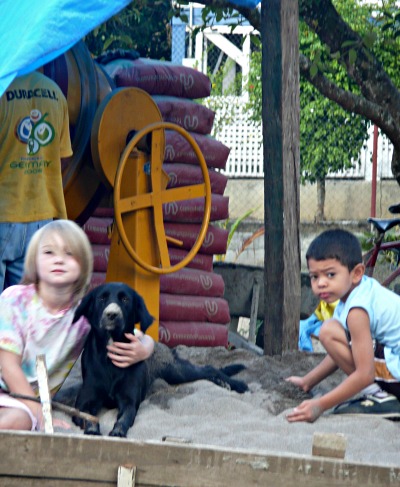
Which is why cement is the typical building material of all of Latin America.
It is also what we use as the primary construction material for our Living in Panama House.
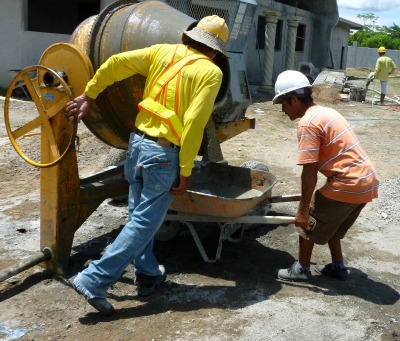
It is wise to keep your construction project within the comfort zone of the local workers. Builders in Panama are most comfortable working with concrete.
Think of Panama as a small town of 100 years ago, where folks are used to doing things the same way, generation after generation. Of course, they can learn new ways, but it won't be a fast, easy, or necessarily successful process.
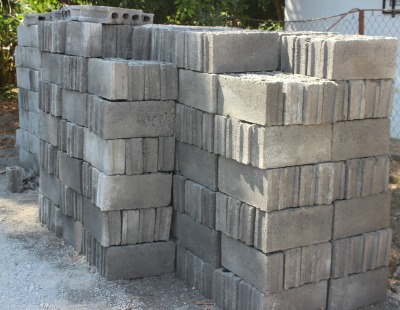
Concrete block is the most common method of construction. It is usually reinforced with steel rebar and the hollow cells in the blocks are filled with a concrete slurry.
Standard concrete blocks are 16” long and are available in 4” and 6” thicknesses.
Half blocks may be purchased to maintain the overlapping rhythm of the block structure. Block may easily be cut with a grinder, or scored and broken to size. (This is the most common method both in Panama and in North America).
As I mention in another article on hardware stores, the quality of block available in Puerto Armuelles varies greatly from supplier to supplier, and even between batches from the same supplier. You need to inspect each shipment, and even every block. Some blocks literally fall apart in your hands, while others are perfectly adequate, especially if you use plenty of steel reinforcement, and fill all cells with concrete.
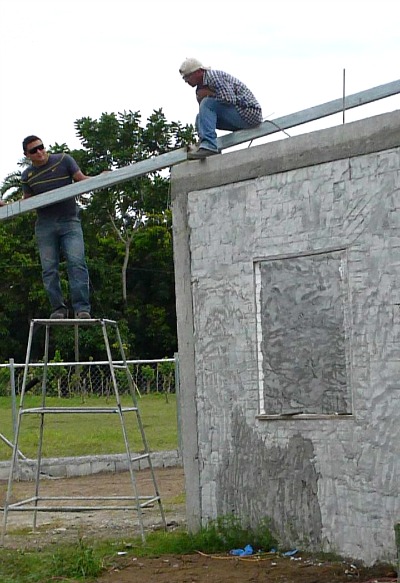
Please note: No block that I have encountered in Panama is of the high quality that one would encounter at a typical home center, or concrete supplier in the States or Canada.
However, I believe that in the very near future, as with everything else in Panama, the quality of local block will rise to the level of that in North America. The growth rate and improvements in quality in Panama are like nothing I have seen anywhere in my lifetime. The pace of growth and modernization in Panama is truly astounding.
Custom Blocks In Puerto
Our best block supplier has agreed to provide custom blocks using a higher ratio of cement to aggregates than his standard block. He will make it your specifications.
In other words, we can start getting that higher North American- quality block in Puerto Armuelles today.
M2 or Convintec is a insulated Styrofoam core panel covered with a galvanized steel mesh that is used
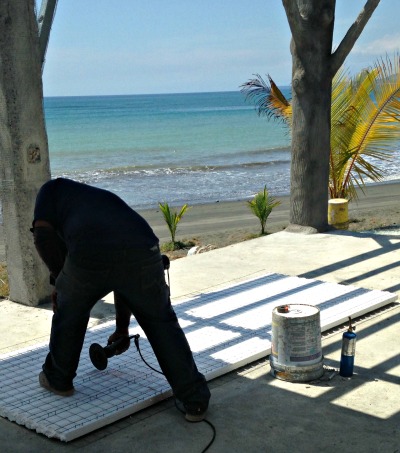
primarily for interior and exterior walls and sometimes for flooring or the roof.
M2 is used in place of concrete blocks, but must be “stucco coated” or "repello" with concrete.
M2 is increasingly popular and allows building to go up very quickly. Some people import higher quality M2 panels than are available in Panama. But most are successful using the locally available M2 panels.
M2 panels come in different thickness. Ideally, you should use panels at least 4 inches thick. Panels thinner than 4 inches have a tendency to buckle and are not load bearing.
Plycem is a fiber cement board widely used to replace wood siding, plywood, tile base in showers, and, at times, sheetrock. It can be cut, sanded, nailed, rough dressed, drilled and screwed with conventional woodworking tools.
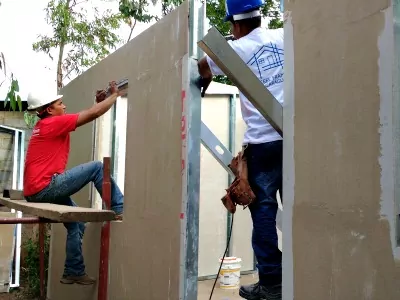
There is a similar product to Plycem available in the States. It is called Hardiboard.
Benefits of Plycem
Plycem is designed to be screwed into wood or steel studs and floor joists. 3/4 or 1" Plycem can even replace plywood floors, when placed on closely spaced floor framing using steel studs or wood.
In our own house, we have used Plycem as the base for a tiled kitchen floor as well as for the floor and walls of our bathrooms.
Thanks.
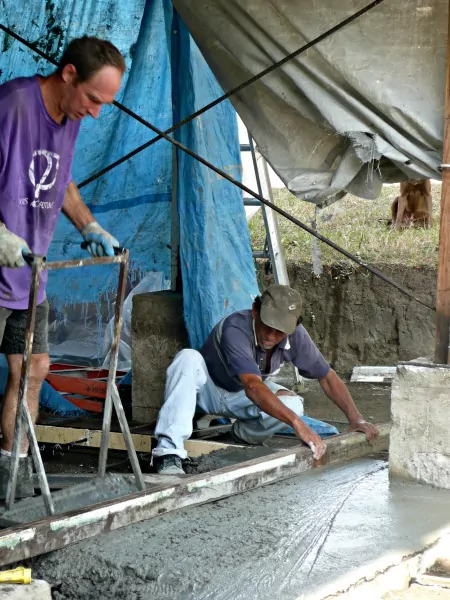
I wrote a post about each of these 4 building materials. The links to those posts are at the bottom of this page.
Whatever construction materials you use for your house, you need think about your choice carefully.
Hopefully, the answer is yes to all of the above questions. If not, make sure you are okay with the extra work and/or cost using your chosen material will entail.
One thing you should be careful about, is using building materials or construction techniques with which the local labor is unfamiliar.
If you get too innovative, you are likely to lose the locals along the way. Certainly, they will not be as interested in trying a new building experiment as you, the northern immigrant. You are in for a shock, if you came to Panama with ego-driven notions of how you would build, once you had moved to paradise, and with labor day rates that are less than half of what hourly rates are up north.
For some of us (I include myself here), this will require that we put our own ego in the “back seat." If you don't, you will face a lot of frustration, cost overruns, and disappointing results.
For me, after a long period of trying get the local builders to do things exactly, precisely my way, I have come to the conclusion that it is just not worth it. Believe me, I have tried it, many times (I am a slow learner). It just does not work. Or if it works, it is not a happy experience for anyone.
There are many wonderful things about the Panamanian people. When taken on their own merits, the people of Panama are kind, peaceful, genuinely warm neighbors, and happy to share their beautiful country with us. However, an intrinsic desire to learn something new, from foreigners no less, is not high on their priority list.
It is my opinion that we expats do best when we accept that fact. When we don’t try to impose our own perfectionism and rigid views upon the locals. Our own culture has certainly made plenty of mistakes, and continues to make mistakes and on a global scale.
Maybe we are being offered this opportunity to compromise a bit, to be less perfectionistic and judgmental . With this attitude well in mind, you can produce an interesting, good quality, project. A project that you can be proud of. And most importantly, you will build your house in a way that will not make enemies of your new Panamanian friends. Those relationships will be a joy for years to come.
July 16, 2016

UPDATE: Del Monte now has full legislative approval to grow bananas in Puerto Armuelles & Baru.
A big crowd had gathered in ESPA's high school gymnasium to hear the news. The Panamanian Minister of the Presidency, Alvaro Aleman, and other officials signed documents.
There was a very long speech by the mayor of Puerto Armuelles, Franklin Valdez, followed by a not-quite-as-long speech by Alvaro Aleman. Nothing surprising was said. Alot of talk of jobs, economic recovery, and how hard they are working to get an agreement with Del Monte to revive the banana industry in the Baru district of the Chiriqui province.
Alvaro Aleman told the crowd that the first step towards reviving the banana industry in Baru was to sign an agreement with Del Monte. However, that agreement must be approved by the Council of Ministers and then ratified by the Panama National Assembly.
"I am confident that this bill, which will be presented in this legislative period, will be passed so that next summer Del Monte can begin its investments in the area," said Aleman.
The minister said that if approved, Del Monte could make up to $220 million in investments in the Baru plantations which will provide, "important sources of work."
He also explained that one of the outstanding issues is how and whether to allow Del Monte to buy the plantations since some of them are within 10 kilometers of the border. The Panama Constitution prohibits foreigners from owning land within 10 kilometers of the border.
Del Monte is interested in acquiring "approximately 2,572 hectares belonging to the State, 840 hectares owed by an agricultural association, and 1,771 hectares that are privately owned." said Aleman.
Varela visits in September & updates Del Monte progress
The atmosphere of the crowd was one of muted and wary optimism. While much was made of the signing of documents, it was only another step in the long process of getting a banana company in Puerto Armuelles. The current talks with Del Monte have been going on for more than a year so far.
Progress has been made. Del Monte has asked to be allowed to hire foreign labor, but it was agreed that they would follow Panama labor laws, which makes bringing in foreign labor very difficult.
There is another company that wants to take over banana production in the plantations in the District of Baru. About a year ago, Coobana, a worker's cooperative also expressed interest in taking over the banana plantations in the Puerto Armuelles area. That proposal was not mentioned during yesterday's meeting.
2 banana worker cooperatives started in the wake of Chiquita pulling out (in Puerto Armulles) and greatly scaling back (in Bocas del Toro). Puerto Armuelles's worker cooperative, Coosemupar, was a dismal failure for many reasons.
On the other hand, Bocas's cooperative, Coobana, continues to be a success. Their success is credited to the critical and successful overture Coobana made to supply bananas to Europe. Coobana has had to modify many of its labor and growing practices to comply with European standards.
Given that the Minister of President of Panama was here to announce further progress in negotiations with Del Monte, Coobana coming to Puerto seems unlikely. However, I think a company run by other Panamanian banana workers would be a good choice for Puerto. Especially a company that has improved both labor practices and safe growing methods.
I am not sure of all the details of the proposal of either Del Monte or Coobana though. I have heard some say that Coobana has already taken over some of the plantations in Baru. Perhaps those are the lands mentioned above that are owned by an "agricultural association". Accurate information can be hard to get in Panama.
For now we will have to wait and see what develops. I know that the owners of Puerto's newest restaurant, Cafe del Mar, are looking forward to a new banana company and the influx of money into the pockets of Portenos.
Enjoy the photo gallery of yesterday's Del Monte meeting. Click on any photo to start the slideshow.